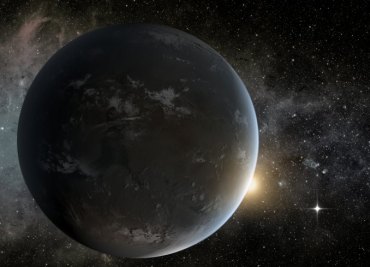Earth-like planets common

During a news conference Monday at NASA's Ames Research Center in Moffett Field, Calif., scientists announced findings from the analysis of Kepler Space Telescope data. About 70 percent of the stars observed by Kepler show planets, they said. And 1 in 5 is orbited by an Earth-sized planet in the “habitable zone,” according to an analysis of Kepler data by Erik Petigura, a doctoral candidate at the University of California, Berkeley.
NASA defines the habitable zone as the distance from a star where an orbiting planet’s surface temperature might be suitable for liquid water.
Scientists also announced the discovery of 833 candidates for new planets, 10 of which are less than twice the size of Earth and orbit in a sun’s habitable zone.
“We’re finding with Kepler that planets seem to be the rule rather than the exception,” Petigura said.
Any other news conference presided over by a row of scientists -- all with advanced degrees and prestigious credentials -- might have drawn yawns. But this was about a telescope designed to search the galaxy for Earth-like planets. While the Kepler is no longer operational, it provided four years of data for scientists by measuring variations in the brightness of more than 100,000 stars every 30 minutes. Scientists searched "for the tiny 'winks' in light output that happen when a planet passes in front of its star," according to NASA.
The NASA event was broadcast live through the government’s website. Twitter followed with a stream of comments that ranged from “wow” to “the geek in me wants the details.”
Discoveries of Earth-like planets will likely continue, predicted Jason Rowe, research scientist with the SETI Institute, Mountain View, Calif. “When I first started working with Kepler right before the launch, I think my expectation coming into this was that there would be maybe a thousand planets. Now we’re seeing over 3,500 planets discovered by Kepler, with a large number of small, Earth-like candidates.”
At one point, a reporter asked William Borucki, Kepler science principal investigator at Ames, “If you had to put money on it, do you think there’s a planet [like Earth] out there?”
“What we can find are planets about the size of the Earth, planets that are in the habitable zone,” Borucki said.
He stopped short of saying there is another planet with mountains and oceans, plants and animals. “We have lots of missions to consider in the future,” Borucki said. “But some of those are likely to be done by our children or grandchildren.”
Planets with atmospheres that would have carbon dioxide—a compound essential for life—and water vapor are likely, Borucki allowed. “CO2 is very common in our galaxy. Water vapors, as well.”
Another reporter pressed, “This galaxy of ours is pretty crowded with exoplanets, sounds like.”
“Well, if we ever get star travel,” Borucki joked, “you’ll probably see a lot of traffic jams. Yes.”

